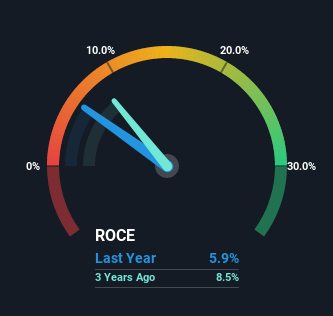Some Investors May Be Worried About Unibel's (EPA:UNBL) Returns On Capital

To avoid investing in a business that's in decline, there's a few financial metrics that can provide early indications of aging. More often than not, we'll see a declining return on capital employed (ROCE) and a declining amount of capital employed. This combination can tell you that not only is the company investing less, it's earning less on what it does invest. In light of that, from a first glance at Unibel (EPA:UNBL), we've spotted some signs that it could be struggling, so let's investigate.
Return On Capital Employed (ROCE): What Is It?
For those that aren't sure what ROCE is, it measures the amount of pre-tax profits a company can generate from the capital employed in its business. The formula for this calculation on Unibel is:
Return on Capital Employed = Earnings Before Interest and Tax (EBIT) ÷ (Total Assets - Current Liabilities)
0.059 = €165m ÷ (€3.9b - €1.1b) (Based on the trailing twelve months to June 2022).
So, Unibel has an ROCE of 5.9%. On its own, that's a low figure but it's around the 5.4% average generated by the Food industry.
See our latest analysis for Unibel

Historical performance is a great place to start when researching a stock so above you can see the gauge for Unibel's ROCE against it's prior returns. If you're interested in investigating Unibel's past further, check out this free graph of past earnings, revenue and cash flow.
What The Trend Of ROCE Can Tell Us
We are a bit worried about the trend of returns on capital at Unibel. Unfortunately the returns on capital have diminished from the 10% that they were earning five years ago. On top of that, it's worth noting that the amount of capital employed within the business has remained relatively steady. This combination can be indicative of a mature business that still has areas to deploy capital, but the returns received aren't as high due potentially to new competition or smaller margins. If these trends continue, we wouldn't expect Unibel to turn into a multi-bagger.
The Bottom Line
In summary, it's unfortunate that Unibel is generating lower returns from the same amount of capital. Investors must expect better things on the horizon though because the stock has risen 4.7% in the last five years. Either way, we aren't huge fans of the current trends and so with that we think you might find better investments elsewhere.
Unibel does come with some risks though, we found 4 warning signs in our investment analysis, and 1 of those is a bit concerning...
While Unibel isn't earning the highest return, check out this free list of companies that are earning high returns on equity with solid balance sheets.
New: AI Stock Screener & Alerts
Our new AI Stock Screener scans the market every day to uncover opportunities.
• Dividend Powerhouses (3%+ Yield)
• Undervalued Small Caps with Insider Buying
• High growth Tech and AI Companies
Or build your own from over 50 metrics.
Have feedback on this article? Concerned about the content? Get in touch with us directly. Alternatively, email editorial-team (at) simplywallst.com.
This article by Simply Wall St is general in nature. We provide commentary based on historical data and analyst forecasts only using an unbiased methodology and our articles are not intended to be financial advice. It does not constitute a recommendation to buy or sell any stock, and does not take account of your objectives, or your financial situation. We aim to bring you long-term focused analysis driven by fundamental data. Note that our analysis may not factor in the latest price-sensitive company announcements or qualitative material. Simply Wall St has no position in any stocks mentioned.
About ENXTPA:UNBL
Mediocre balance sheet low.
Market Insights
Community Narratives



